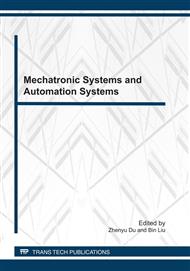[1]
Z. Zhang. Design of Switch Mode Power Supply. Publishing House of Electronics Industry, Beijing, 1999 (in chinese).
Google Scholar
[2]
Z. Wang, J. Huang. Power Electronic Technology. China Machine Press, China, 2000 (in chinese).
Google Scholar
[3]
Z. Leng, Q. Liu, H. Wang. Discrete Mathematical Model of DC-DC Converter. Journal of System Simulation, 2008, 20(10): 5672-5676 (in chinese).
Google Scholar
[4]
M. Ding, G. Wang, H. Yang. Analysis of three discrete models for digital control of DC-DC converter. Relay, 2004, 32(14): 8-11 (in chinese).
Google Scholar
[5]
W. Lu, L. Zhou, Q. Luo, X. Zhang. Control of Bifurcation in the Voltage-Mode Buck Converter. Transactions of China Electro technical Society, 2009, 24(4): 133-138 (in chinese).
Google Scholar
[6]
Y. Shen, J. Chen, Z. Ji. Design of nonlinear controller for buck converter. Electric Power Automation Equipment, 2008, 28(12): 56-59 (in chinese).
Google Scholar
[7]
K. Wang, C. Wang, L. Zhang. Modeling and Chaotic Phenomena Simulation of Buck Converter in CCM and DCM. Journal of System Simulation, 2008, 20(14): 3881-3884 (in chinese).
Google Scholar
[8]
A. Davoudi, J. Jatskevich, T. Rybel. Numerical state- space average -value modeling of PWM DC-DC converters operating in DCM and CCM. IEEE Transactions on Power Electronics, 2006, 21(4): 1003-1012.
DOI: 10.1109/tpel.2006.876848
Google Scholar
[9]
W. Aloisi, G. Palumbo. Efficiency model of boost DC-DC PWM converters. International Journal of Circuit Theory and Applications, 2005, 33(5): 419-432.
DOI: 10.1002/cta.329
Google Scholar
[10]
W. Cao, Y. Yang. Simulation Analyses of Boost Converter Based on State-space Averaging Principle. Journal of System Simulation, 2007, 19(6): 1329-1334 (in chinese).
Google Scholar
[11]
Lehan B. Extensions of averaging theory for power electronic systems[J], IEEE trans. On power Electronics(S0085-8993), 1996, 11(4): 542-553.
DOI: 10.1109/63.506119
Google Scholar
[12]
B. Yang, Y. Liu. Parallel topology of multilevel reinjection current source converter. Electric Power Automation Equipment, 2009, 29(3): 78-82 (in chinese).
Google Scholar
[13]
H. Ma, Q. Feng. Fixed-frequency PWM sliding-mode control of buck switching converter based on precise feedback linearization. Electric Power Automation Equipment, 2009, 29(8): 28-32 (in chinese).
Google Scholar
[14]
Y. Shen, Z. Ji, G. Y. Modeling and simulation of DC/DC converter based on VISSIM discontinuous conduct mode. Electric Power Automation Equipment, 2008, 28(6): 59-62 (in chinese).
Google Scholar


